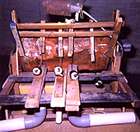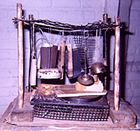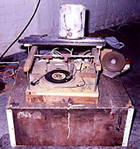machines sonores
november 09, 2004.
My mother's mother owned a beautiful antique music box, that in turn, I guess, she got from her mother. The thing, antique as long as I knew it, must have been pretty old.
My grandmother - god bless her soul - was born in 1897.
It was a big shiny trunk sized wooden box. If one lifted the box's cover, one marveled at the well-conserved all-metal mechanics inside, protected by a glass plate: a big metal cylinder adorned with small metal spikes, that picked several octaves worth of tuned metal strips, and controlled metal 'drumsticks' that hit a series of bells (they're must've been some ten or twelve of them). In order to get the box to play, it had to be wound up by means of a handle that sat in a narrow space to the left of the sound producing mechanism. One pulled the handle, several times, which made a loud rhythmical krshhjj - krrrshjjj - krshhjj grinding noise, to get the metal cylinder to start turning.
Then the music played.
The box's 'repertoire' was handwritten in black curly letters on a piece
of paper attached to the inside of the cover. It was considerable. If I
remember rightly the box played at least twenty different 'popular' tunes,
but from all of these I only recall the Marseillaise by name ...
(You can hear a couple of seconds of my grandmother's box playing at the
beginning of the "Quirass
Tapes" track X-IIa ... ![]() ).
).
As a young kid, when visiting my grandparents, I often sneaked up to the
first floor of their house, to see, to touch and to listen to the box.
It was standing on a small table, in an empty room...
There was something magical about this box-on-a-table; about watching the
small and large cogs moving one another and the spiked cylinder, while listening
to the 'old-time' tunes, with the stuttering metallic percussion accompanying
them, including the occasional glitches, the false notes, the cracks,
hicks and ticks produced by the mechanics; it grinded on and on, until the
cylinder gradually slowed down, and there was this last and ultimate !>ping<!
that sounded, or a final !>ranggg<! of one of the bells,
fading me back into the silence of the empty room.
These early memories are surely part of the reason why I was so very much enchanted by Frédéric le Junter's machines sonores installation, which - until november 14th - can be seen and heard in "994 m2", the large new concert-, exposition- and performance space in Montreuil (2, rue Emile Zola), recently acquired by the Instant Chavirés.
 |
 |
 |
Frédéric builds (electro-)mechanical sound machines from
'found' materials: old record players, pieces of wood, flutes, pipes, springs,
flower pots, cans, hand drums, metal, shells...
There are four of them at "994 m2", laid out across
the floor of the exposition space. Four mechanical junk bands, each with
a different 'sonority', a different 'tune'. Each with its own 'sounding
soul', and all playing in 'cycles', which, due to many a random element
built into the mechanisms, maybe are 'similar', but never 'identical'. The
visitors can start such a cycle, by means of an electrical switch. Each
lasts several minutes and is independent from the other machines' cycles.
To give an example: one of the machines is a 'flower pot carillon',
consisting in twelve flower pots arranged at regular intervals in a demi
circle. The pots have different sizes, which accounts for the 'approximate'
tuning of the 'gamelan'-like playing that results when the hit'm
mechanism (powered by 12 old record players) that 'plays the pots' is set
into motion... This 'flower pot gamelan' maybe is the most 'traditional'
sounding of the four machines sonores. My favorite one is the long
line ('axis') of 'percussion objects' (african hand drums, large metal springs,
...), played by loosely dangling pieces of wood, that are slowly being turned
around and round ... You can walk along the line, from one end to the other,
then around it, and back the other way, and hear how the axe's
music shifts with your displacement in the space.
Sonically the most impressive, the most bruitish of the four, is
the machine that at "994 m2" is placed opposite
the 'axis'. It is composed from a number of connected, but very different,
'discrete', modules. Like a 'flute blowing' machine. Or a record
player with two pick-up arms, playing back 'locked grooves' on a worn copy
of a Stiff Records 7" (Theatre of Hate's Propaganda, from
1982).
The space, its vastness - empty, like that room in my grandparents'
house - I found essential to the perception of the machines. And
of their music. Which, of course, resides in the mix of the divers
sounds and rhythms produced by the 4 of them, as they are 'randomly' summoned
into action by the Instants' visitors.
By magic ...
And given the materials used in their construction, isn't it just natural,
that put together, theirs is a music often very much like that of a Partch
mécanique?
[ note dec. 2004: listen to the sound of the machines:
Frédéric le Junter was kind enough to allow me to add a selection
of the recordings I made at the Instants of the playing of his
machines sonores to the second
edition of Raudio ...
note dec. 2005: watch a nice series of videos
of the Machines Sonores, by Alain Longuet and/or Frédéric
le Junter.
(Text slightly modified : september 27th, 2006)]
[ Next related SB-entry: brahem machines ]
comments for « machines sonores » ::
|
Comments are disabled |